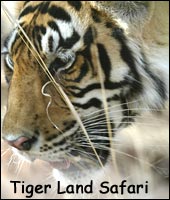HOME : Custom Made Tour
About Snakes
Snakes are considered by many as perhaps the most dreadful of all animals that co-inhabit our planet. Most of the fear about snakes prevails due to the total ignorance about these graceful, agile and useful creatures. In India, snakes are part our mythology, yet, our first reaction on seeing a snake is panic, fear and thought to exterminate it.
If a snake is found on farms or near human habitation, the general response varies from shock to intense fear. In general, snakes are killed because of our ignorance and deep-rooted superstitions, which is also responsible for loss of human lives.
People often ask us, what good are snakes? We do not like them, and also, they pose a threat to our life, so why do we need them? Snakes appear to rank at the top of the unpopularity polls of the world’s fauna. If all the snakes disappear from the earth tomorrow, we would soon be overwhelmed and overrun by rats and mice. Our crops would be devastated and massive food shortages would follow.
Man’s great fear of snakes is an impediment to conservation related activity. However, it can also be taken as an opportunity to educate people about wildlife conservation. The awe and fascination snakes inspire makes them the ideal animals to begin education.
Of course, educating people about these most misunderstood reptiles is really an uphill battle. It is often an almost impossible task to argue a case in support of venomous snakes, despite their place in complex, ecological chain and knowing very well that we are part of this delicate chain. Snake venom helps in saving human lives. Cobra venom is used in medical research because it has an enzyme, Lecithinase that dissolves cell walls as well as membranes surrounding viruses. Other medicines from snake venom treat cancer and excessive bleeding, and several painkillers are made from venom extracted from venomous snakes.
In spite all these facts, this attitude is due to our ignorance about these creatures and the shortage of useful informative literature about snakes. Snakebite is an emotive subject shrouded in myth, folklore and other exaggerated misconceptions by our media, feature films, and the community of snake charmers who disseminate false information and mislead people from the truth about snakes.
About Indian Snakes
There are about 250 species of snakes in India, of which about 55 are venomous and only four pose threat to human beings, as they are found in the vicinity of human settlements, especially in rural areas which are agricultural and have rats in abundance. The four venomous snakes are called Big Four – the Spectacled Cobra, Common Krait, Russell’s Viper and Saw Scaled Viper.
Spectacled Cobra
Common Krait
Russell’s Viper
Saw Scaled Viper
Anatomy of a Snake
Although snakes are characterized by having neither limbs nor eyelids, several lizards share one of these characteristics, and the origin of snakes lies with lizards. As efficient hunters, prey are located by sight, as well as via chemical cues, which are collected with the aid of their bifid tongues and carried forward to a special sensory organ, located in the roof of the mouth, called Jacobson’s organ. Pit vipers and pythons, in addition to this oral organ, have thermal receptors on or near their lips, which permit them to detect the ody heat of warm blooded prey in darkness. More Info soon…
Life Span: The age to which snakes can survive under wild conditions is virtually unknown. In captivity, their natural life-span are probably exceeded in many cases, given the fact that they are protected against diseases, parasites and predators, and that they have access to a more predictable food supply.
Most colubrid species, such as king-snakes and rat-snakes, will live for twelve to fifteen years or more in captivity, and breed right up until the end of their lives. Species with a more active lifestyle probably fall slightly short of these ages.
Most medium-sized snakes can reach sexual maturity by the time they are two years of age if they are fed well while they are young. Others take three or more years, especially if they are larger or if they go through periods of hibernation, during which their growth will obviously be arrested. Sexual maturity is reached when snakes are approximately half-grown. Unlike birds and mammals, snakes have an indeterminate growth pattern. This means they can continue to grow throughout their lives, although their growth rate slows down with age.
Sex Determination: If breeding is to be attempted, it is obviously important to be able to tell the difference between male and female snakes. Not only will this be necessary in order to put together a pair in the first place, but any resulting offspring will usually need to be sexed before they are disposed of. Few snakes show any external differences between the sexes, and males and females can only be identified by examining their reproductive organs. Males have paired hemipenes which are normally inverted (turned inside out) and lie along the base of the tail. When mating takes place, one or other of these hemipenes is everted (pushed out), through the cloacal opening, and used in copulation. Sex determination therefore consists of examining the snake for the presence of hemipenes. There are three common ways in which this can be done.



